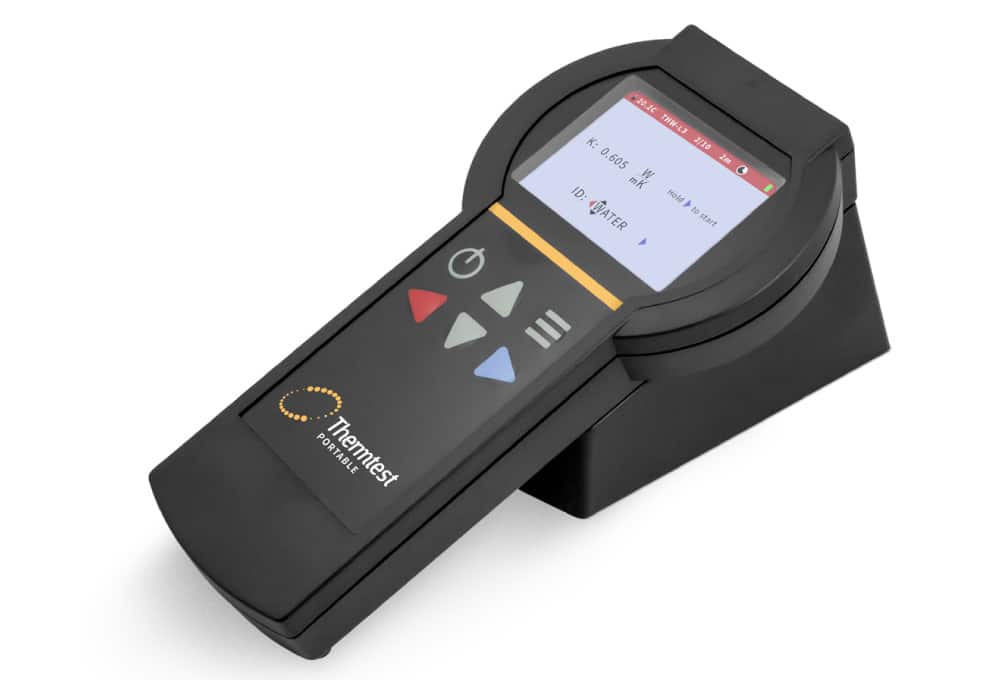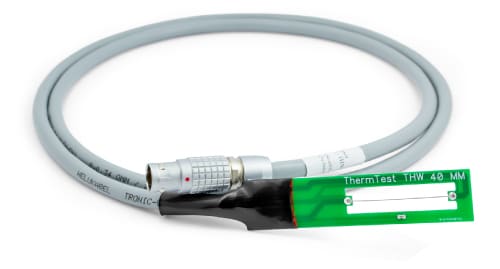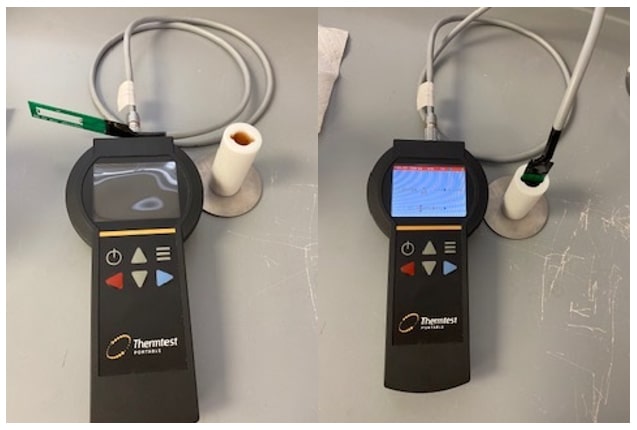The Measurement Platform-2 (MP-2) is an advanced meter with unique selection of transient thermal conductivity sensors for a variety of applications, with a focus on primary measurements. The transient thermal conductivity sensors share similar principles of operation. The sensor wire is heated using a constant current source (q) and the temperature rise is recorded by monitoring the change in electrical resistance of the wire (THW and EFF) or by resistance temperature detector device (TLS). For samples of high thermal conductivity, resistance increases more slowly over time; for samples of low thermal conductivity, resistance increases more quickly over time.

Picture 1. Thermtest MP-2 Thermal Conductivity Meter
Thermal conductivity MP-2 users benefit from the convenience and accuracy gained when using primary testing methods. The MP-2 controller auto-detects the connected sensor and loads corresponding testing parameters. Measurements are easily performed with the smart on-board software and transferred to computer with an included Windows utility program.

Picture 2. Thermtest THW-L3 sensor for use with the MP-2 portable meter.
The Transient Hot Wire – THW-L3 sensor is one of the many sensors offered with the Thermtest portable measurement Platform (MP-2). This sensor offers simple yet accurate measurements of liquids, pastes, and powders from 0.01 to 1 W/m/K via the transient hot wire method. The THW-L3 adheres with an internationally recognized standard of testing by complying with ASTM D7896-19. The THW-L3 has a 5% accuracy and a 2% reproducibility of measurement, making it a highly accurate and precise instrument for measuring the thermal conductivity of liquids, pastes, and powders.
The THW-L3 has a detect current setting that determines the appropriate amount of current to apply based on a test measurement. By reading the result of the test measurement, a current will be set that results in an optimal temperature rise of the sample during testing. The accompanying sample holder can be filled with ~15ml of any oil or liquid sample and the sensor can be subsequently inserted in the sample holder. An alternative method of measuring the thermal conductivity of a liquid sample is to insert the THW-L3 directly into the vessel containing the sample.
Motor oil is used in various types of combustion engines, such as in automobiles or smaller equipment like lawnmowers. It serves as a lubricant, to reduce friction between moving parts in the engine. Motor oil is also used to keep the engine cool and avoid overheating, by carrying heat away from the moving parts. This ability to carry (or conduct) heat is referred to as thermal conductivity, and this is a material property that can be measured quickly and accurately with the Thermtest THW-L3 sensor.
In this application sheet, motor oil is measured via THW-L3, after calibration with DIUF water. The thermal conductivity of similar industrial oils has been found to be between 0.1 and 0.2 W/m/K with the Thermtest THW-L1. The THW-L3 operates on the same principles as the THW-L1.

Figure 1: Measuring motor oil with the THW-L3 at room temperature. The oil (15 ml) is poured into the liquid cell and the sensor is then placed in the sample holder.
Table 1: Results of measuring motor oil with the THW-L3.
| Average Thermal Conductivity (W/m/K) | Standard Deviation (W/m/K) |
|---|---|
| 0.126 | 0.002 |
The THW-L3 has a 5% accuracy and a 2% reproducibility of measurement, making it a highly accurate and precise instrument for measuring the thermal conductivity of liquids, pastes, and powders.